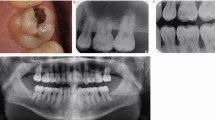Abstract
Design
A single-blind randomised controlled trial was conducted in a university prosthodontics department in Germany.
Intervention
Only people who presented a clear-cut clinical diagnosis of anterior disc displacement without reduction (ADDWR) were included: limited mouth opening with deflection, and limited lateral movement of the incisors and/or pain had to be found. Additionally, patients had to present at least one antagonistic molar contact on each side. The clinical finding was verified by magnetic resonance images in open and closed mouth positions. After clinical examination and imaging, centric splints or distraction splints were randomly assigned. Patients were instructed to wear the splint 18 h each day. Directions as to the care of the splint were given.
Outcome measure
After 1, 3 and 6 months of therapy, patients provided their subjective evaluation by filling out a visual analogue scale form. Any change in their pain level or functional performance level was recorded. The outcome was evaluated using the Wilcoxon signed rank test for matched pairs. Success after 6 months was defined as improvement in active mouth opening of greater than 20% and pain reduction (on chewing) of at least 50%. Success was statistically verified using a logistic regression test.
Results
A total of 74 patients (65 females and nine males) fulfilled the inclusion criteria and agreed to participate. Thirty-eight patients received a centric splint and 36 a distraction splint. The improvements in mouth opening were significant in both groups. The improvements in pain on chewing, pain during other functions, pain at rest, functional limitation on chewing and other functions were also comparable in the two groups. The logistic regression test, however, suggested that patients using centric splints were treated more successfully than the others (odds ratio, 2.88; 95% confidence interval, 1.01–8.74).
Conclusions
Centric splints seem to be more effective than distraction splints. Therefore, before the surgical treatment of ADDWR, centric splints should be used instead of distraction splints.
Similar content being viewed by others
Commentary
Patients with ADDWR in one or both temporomandibular joints usually suffer significant reduction in the quality of life because of the pain and limitation of mandibular movement. This paper examines the success of two different types of occlusal splints.
The results are important because they suggest that a significant number of patients can be helped without the need for surgical intervention, and the authors report that one type of splint is more effective than the other. The paper will be of interest to practitioners as well as specialised units, because splint therapy can (and should) be available in primary care. It is well-referenced in respect of nonsurgical treatment of ADDWR, although some references to back up the authors' comments on the benefits of surgical intervention would have made their literature review complete.
The two splints differ in their construction and design and for this reason the trial could not be double-blind. Despite these differences, the authors report and give references supporting how both splints reduce the pressure on the joint. A potential source of misunderstanding is that one of the splints is called a “centric splint” in most places in the text, but a “stabilisation splint” in others. Some readers may be confused by this. It may have been better to use the term “stabilisation splint” and avoid the word “centric” altogether because most people would agree that the definition of ‘centric relation’ assumes that the disc is in place. Although this is a slightly pedantic criticism, the confusion could have been avoided by using Dawson's classification,1 which describes a comfortable and reproducible jaw relation in terminal hinge axis even if the disc is displaced. The authors describe this as, “the condyle physiologically seated in the mandibular fossa”.
The patient groups are well-matched and the trial is well-designed. I had some anxiety about considering a subject with a 20% increase in opening as an improver until I noted that the initial lowest active opening was 20 mm. This simple percentage-improvement criterion would be less accurate is someone with a severe limitation of, say, 15 mm. The dropout rates of 10.5% and 16.6% were also initially of concern until I noted, from the Tables again, that this only referred to the final review of 6 months. The numbers were good up to 3 months and the overall success at earlier interval was still impressive.
This is a report of a well-designed trial that should lead to less surgical intervention for patients suffering from this troublesome and relatively common temporomandibular disorder: I commend it.
References
Dawson PE . A classification system for occlusions that relates maximal intercuspation to the position and condition of the temporomandibular joint. J Prosthet Dent 1995; 75:60–66.
Author information
Authors and Affiliations
Additional information
Address for correspondence: Dr M Schmitter, Department of Prosthodontics, University of Heidelberg, Im Neuenheimer Feld 400, 69120 Heidelberg, Germany. Email: marc_schmitter@med.uni-heidelberg.de.
Schmitter M, Zahran M, Duc JM, Henschel V, Rammelsberg P. Conservative therapy in patients with anterior disc displacement without reduction using 2 common splints: a randomized clinical trial. J Oral Maxillofac Surg 2005; 63:1295–1303
Rights and permissions
About this article
Cite this article
Davies, S. Centric splints more effective than distraction splints in anterior disc displacement without reduction?. Evid Based Dent 7, 50 (2006). https://doi.org/10.1038/sj.ebd.6400404
Published:
Issue Date:
DOI: https://doi.org/10.1038/sj.ebd.6400404



